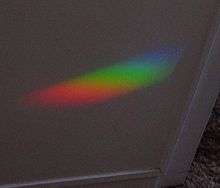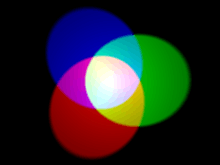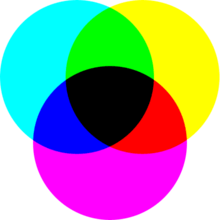Color mixing

There are two types of color mixing: Additive and Subtractive. In both cases there are three primary colors, three secondary colors (colors made from 2 of the three primary colors in equal amounts), and one tertiary color made from all three primary colors. This point is a common source of confusion, as there are different sets of primary colors depending on whether you are working with additive or subtractive mixing.

Additive Mixing
The additive mixing of colors is unintuitive as it does not correspond to the mixing of physical substances (such as paint) which would correspond to subtractive mixing. For instance, one can additively mix yellow and blue by shining yellow light together with blue light, which will result in not green but a pinkish light. As in this example, one should always have the mixture of light in mind when considering additive color mixing as it is the only situation where it occurs. Despite being unintuitive, it is conceptually simpler than subtractive mixing. Two beams of light that are superimposed correspond to additive mixing.
By convention, the three primary colors in additive mixing are red, green, and blue. In the absence of color or, when no colors are showing, the result is black. If all three primary colors are showing, the result is white. When red and green combine, the result is brown. When red and blue combine, the result is purple. When blue and green combine, the result is cyan.
Additive mixing is used in television and computer monitors to produce a wide range of colors using only three primary colors. A pixel is a juxtaposition of these three primary colors. Projection televisions typically have three projectors, one for each primary color.

Subtractive Mixing
The mixing of colored physical substances corresponds to subtractive color mixing, hence it corresponds to our intuition about mixing colors. To explain the mechanism, let us consider mixing red paint with yellow paint. The red paint is red because when the ambient light strikes it, the composition of the material is such that it absorbs all other colors in the visible spectrum except for red. The red light, not being absorbed, reflects off the paint and is what we see. This same mechanism describes the color of all material objects -- note that light is not a material object -- and so applies to the yellow paint as well. Making recourse to the figure above demonstrating additive color mixing, one sees that yellow light is composed of a(n additive) mixture of red and green light. When we mix the two paints, the resulting substance has red paint and yellow paint. The yellow paint absorbs all colors except for red and green. However, the red paint will absorb the green reflected by the yellow paint. The red paint can be said to subtract the green from the yellow paint. The resulting paint reflects only red light and so appears red to our eyes. Note however that this description is theoretical and that the mixing of pigments does not correspond to ideal subtractive color mixing because some light from the subtracted color is still being reflected by one component of the original paint. This results in a darker and desaturated color compared to the color that would be achieved with ideal filters.
By convention, the three primary colors in subtractive mixing are yellow, magenta and cyan; however, for a long time painters have used yellow, red and blue in place of these. In subtractive mixing of color, the absence of color is white and the presence of all three primary colors is black. The secondary colors are the same as the primary colors from additive mixing, and vice versa. This is not an accident. By mixing additive secondary colors subtractively one can reachieve the primary additive colors. Subtractive mixing is used to create a variety of colors when printing on paper by combining a small number of ink colors, and also when painting. Green is a part of mixing yellow and blue. Orange is a part of mixing red and yellow. Purple is a part of mixing blue and red.
See also
External links
- Interactive Java applet on the additive mixing of RGB colors by Wolfgang Bauer
- Interactive Java applet on the subtractive mixing of CYM colors by Wolfgang Bauer
References
- Macaulay, David and Neil Ardley (1988). The New Way Things Work. London: Dorling Kindersley Ltd. ISBN 0-395-93847-3.